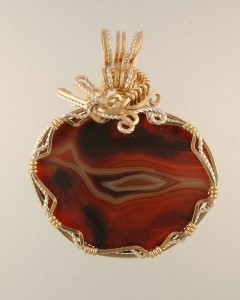Victoria Stone is one of my favorite lapidary materials. Recent research has determined that Victoria Stone is actually leaded glass. VS was created by Dr. S. Iimori in the late 1960’s and early 1970’s. I have noticed that Iimori’s name is spelled several ways on assorted websites (ex. Imori), but the spelling I have comes from an article originally published in Lapidary Journal, so I assume it to be the correct spelling. Articles from Lapidary Journal that I located show piles of natural materials (quartz, magnesite, feldspar, calcite, fluorspar, and others) stacked near Iimori’s laboratory in Tokyo. Smoke and glass? Perhaps…
Iimori never patented his process, only he, and his son apparently knew the secrets to the whole process. Very mysterious indeed (Twilight Zone note playing in my head).
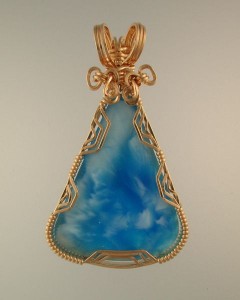
“These materials were pulverized to dust and melted into molten masses. The secret beauty of Victoria Stone comes from the “crystallizers and crystal habit regulators” which Iimori added to the molten mix. The molten material resulting from the brewing was poured into molds and cooled under pressures, up to 2000 pounds, for several months.” How much of this is smoke and glass (no pun intended), is debatable. The same old Lapidary Journal the above quote came from, claimed that Victoria Stone actually analyzed the same as Nephrite Jade. Modern methods using SEM’s (scanning Electron Microscopes), and other scientific methods has rebuked this claim. We are certain today that Victoria Stone was not made much different than Leaded Glass is today, but the rub is in the details of how exactly it was made. There is much mis-information on the web about Victoria Stone, and as with all Internet information it seems to have grown into folklore. Most people that sell this material will claim they this material is actually a man made gemstone, made from natural materials. Well glass is made from sand, and that is a natural material. Make your own judgements on that.
When the Victoria Stone “boule” was released from its mold they had a crust on them. This crust is indicative of a glass mixture. I know of recent (2014) analyzation of Victoria Stone indicates it to be a form of leaded glass. All those working on re-inventing Victoria Stone are working on glass formulas. Perhaps all the stories of this material being artificial Jade are being disproved.
I have always thought Victoria Stone cuts and fractures ALMOST like glass. What puzzles me is it seems to have an oily, slippery texture unlike any glass I’ve cut. The oily feel of the cut could be caused by the lead content in the glass. The questions I have on how Victoria Stone was made are many. Why, if it is glass, did these boules have to be cooled under pressure over a long period of time? I assume it was so the crystals could form properly. Why was Iimore’s son not able to re-produce Victoria Stone without it falling apart? I predict one of the many re-inventors working on making VS will eventually discover the elusive secret. You will see glass that looks like Victoria Stone. Remember you saw it here first.
I own a pair of these rare boules, which are a cylindrical shape with one flattened end and weight perhaps 3-4 pounds. My friends have told me that when working this material you had to remove the crust carefully and let the boule rest for a few weeks. They say that the boules would actually make cracking noises when the crust was removed. Expansion inside the boule caused these noises. The older the boule, the less cracking could be heard. They would cut a couple slabs off each end of the boule; leave is set for a couple weeks, and then cut two more slices off each end, etc.
The boules I own are calling me to cut them; and I may do just that in the near future. One of the boules is white and still has the “crust” on it, while the other one is gray and the crust or bark has been removed.
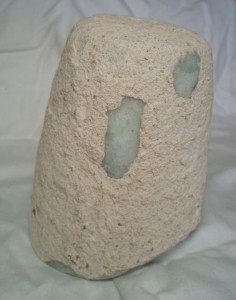
A white boule with the “crust or bark” still on it.
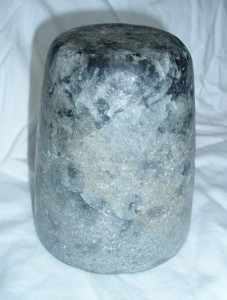
A “peeled” gray boule.
I decided to update this post , that I first posted on May 8, 2009, to add this information and pictures of my boules. I believe there are very few full boules left after forty years, and I wanted to give you the opportunity to see them before I cut them up. I acquired these boules in an estate sale a couple years back. The gray boule is especially rare. I am hoping that the boules are not cracked inside too badly. I may even Youtube (is that a verb?) the cutting procedure for you later this year. Cutting a full Victoria Stone boule is impossibly rare after all these years. There are just that many around anymore. All the boules Iimori produced were approximately five inches tall, four inch base, tapering to a rounded top of approximately three inches.
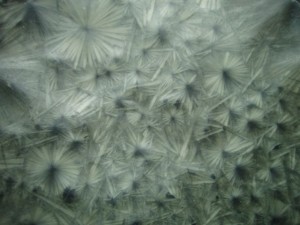
A view of the stars on the bottom of the boule.
Another unusual crystallization habit to Victoria Stone Boules is that you see “star crystallization” only at the bottom and near the surface of these boules. So IF you see stars on a piece of Victoria Stone, you know it is that very rare and most coveted bottom slice. I describe this piece as the “Filet Mignon” of the boule, and get a premium for this piece if I ever see one.
Victoria Stone boules were sold at the Tucson Gem Shows in the 70’s. Also cabochons were available to purchase at the shows. I wish I had invested all my money in this stuff back then, as it is unbelievably expensive today, and virtually impossible to find. I have purchased entire rock collections just to get a small quantity of Victoria Stone. We are one of the few sites on the Internet to offer Victoria Stone Jewelry.
Iimori actually manufactured an artificial jade that he called “meta Jade”.I still have some of this material and it is hard to tell the difference between it and natural Imperial Jade. When Victoria Stone cooled, it re-crystallized from its molten state; forming beautiful feather-like chatoyant crystals.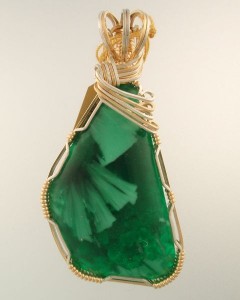 I see similar crystallization in Pectolite (Larimar), Thomsonite, Isle Royale Greenstone, and Prehnite.
I see similar crystallization in Pectolite (Larimar), Thomsonite, Isle Royale Greenstone, and Prehnite.
Victoria Stone was originally produced in fifteen colors: green, sky blue, reddish purple, yellow green, blue green, sky indigo, chocolate, yellow, deep indigo, white, black, grey, quiet blue, quiet yellow, and quiet green. I have posted two photos of blue green Victoria Stone so you can see how the crystallization varies from stone to stone.
The first version of the Victoria Stone story is that Dr. Iimori died in the late 70’s or early 80’s and never told anyone how he produced Victoria Stone. Kenzo Kato, Iimori’s son, ran Iimori Laboratory Ltd., but was never informed of the secret to making Victoria Stone. I could never imagine not writing down somewhere how you did something as wonderful as making Victoria Stone, but this is what is said to have happened.
The alternate version of the aforementioned story that I have recently received from a trusted expert I know is that Dr. Iimori did in fact pass the formula to his son, Kenzo Kato. KATO did make a batch or a few batches of Victoria Stone which was sold on the market. There was a problem with the Victoria Stones stability from Kato’s batches. The batches were not stable enough for lapidary work. Apparently the problem was in the cooling, pressure, or some other factor which was not passed on to Kato. Shortly thereafter Kato went out of the Victoria Stone business. This second version makes far more sense than the first story which is generally thought to be the definitive truth. I believe that the story that Kato did know the formula is more creditable then the story that is generally thought to be the truth.
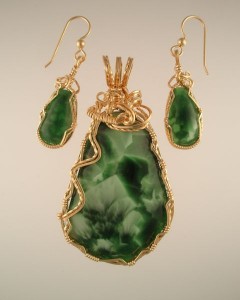 Mysteries still abound as to how exactly Victoria Stone was created. There have been lots of years and lots of research and experimentation on how this glass was actually made. How did these “crystals” form in the boules? Were these boles actually cured under pressure? Why was this glass poured into boules in the first place? A big question I have is why the crystallization on the bottom of the boule is different from the rest of the boule? Why, when Iimori’s son tried to reproduce the is material, did it fall apart? Some glass, like Goldstone is quite tricky to make. It takes exacting manufacturing and curing to come out correct, and this may have been the issue with Victoria Stone. Who really knows? There are many people trying to make this old treasured material, and have been, for many years. I have seen material labeled “Victoria Stone” in Tucson, that was not Victoria Stone.
Mysteries still abound as to how exactly Victoria Stone was created. There have been lots of years and lots of research and experimentation on how this glass was actually made. How did these “crystals” form in the boules? Were these boles actually cured under pressure? Why was this glass poured into boules in the first place? A big question I have is why the crystallization on the bottom of the boule is different from the rest of the boule? Why, when Iimori’s son tried to reproduce the is material, did it fall apart? Some glass, like Goldstone is quite tricky to make. It takes exacting manufacturing and curing to come out correct, and this may have been the issue with Victoria Stone. Who really knows? There are many people trying to make this old treasured material, and have been, for many years. I have seen material labeled “Victoria Stone” in Tucson, that was not Victoria Stone.
I cut Victoria Stone on my Genie as I would any glass. It does polish very easily using any normal method you regularly use for polishing glass. Victoria Stone is quite resistant to edge chipping. You should never use a 90 grit wheel on it. You also have to watch for natural holes in this material, and work around these small imperfections. You do not have to burnish Victoria Stone like you do jade to get a good polish. Victoria Stone produces a superior polish without heat. I would not recommend heating Victoria Stone up too much while polishing it lest you accidentally crack it. I have not personally cracked a stone, but have been told that this is a possibility.
Recently, someone posted up some pieces of Victoria Stone they found in Tucson or Quartzite. Never buy Victoria stone in broken chunks. You have to remember that this is a glass-like material and if a boule was dropped of broken up, all these pieces will be cracked and virtually unusable. Always purchase VS in slabs or cabs if you find any.
I’ve been wanting to update this post for a while, with new information. I also have an original color chart, soon to be posted. I hope you enjoy this new information.
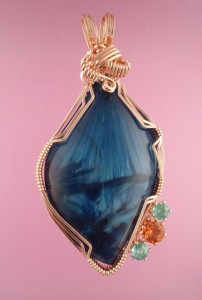
A Deep Indigo Victoria Stone with facetted Apatite and Carnelian.
Check out all our Victoria Stone Jewelry now.I expect that this beautiful stone jewelry will continue to increase in value as time goes on.
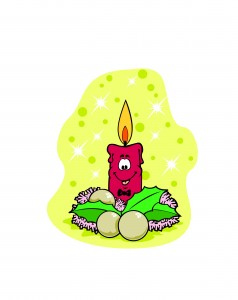
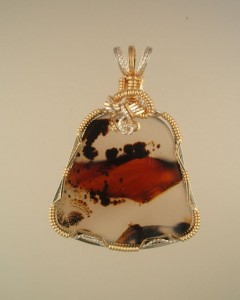 But wouldn’t your own special stone lover treasure a unique picture rock or mookaite jasper or a moss agate or picture jasper that no one else in the world has a duplicate of? These unique hand crafted jewelry pendants are our specialty, unusual gemstones, wire wrapped with artistry and precision, and providing a lifetime of beauty.
But wouldn’t your own special stone lover treasure a unique picture rock or mookaite jasper or a moss agate or picture jasper that no one else in the world has a duplicate of? These unique hand crafted jewelry pendants are our specialty, unusual gemstones, wire wrapped with artistry and precision, and providing a lifetime of beauty.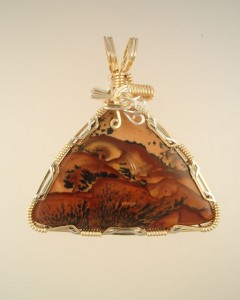
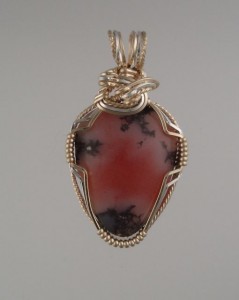


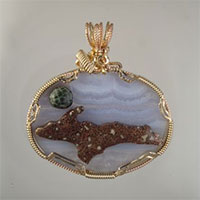
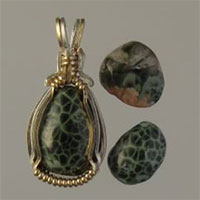
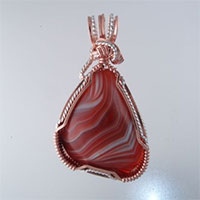
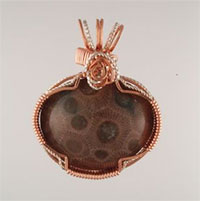
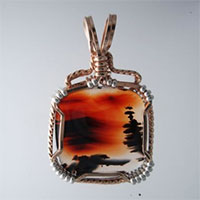
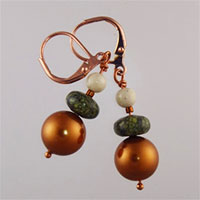
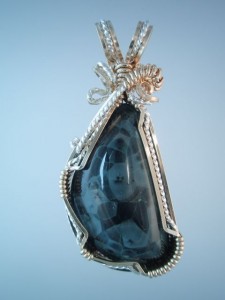
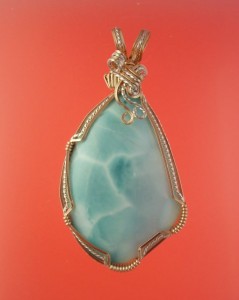
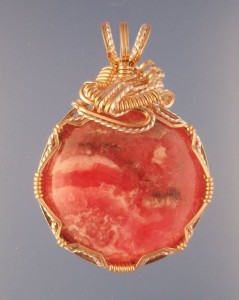
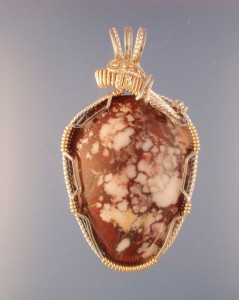
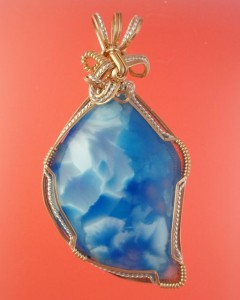
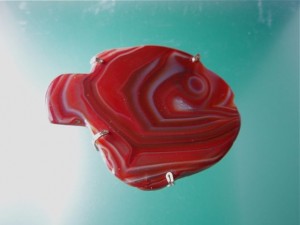
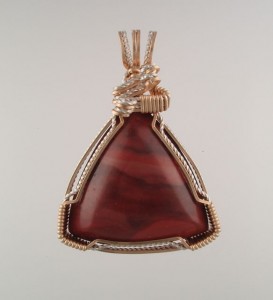
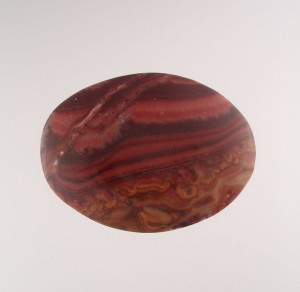
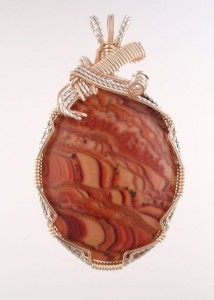
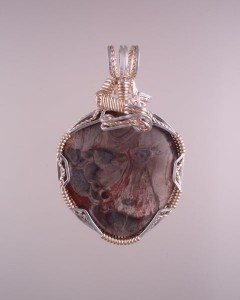 The drawing of the dogman on this website resembles the picture in the mushroom rhyolite I just cut.
The drawing of the dogman on this website resembles the picture in the mushroom rhyolite I just cut.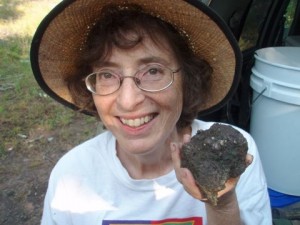
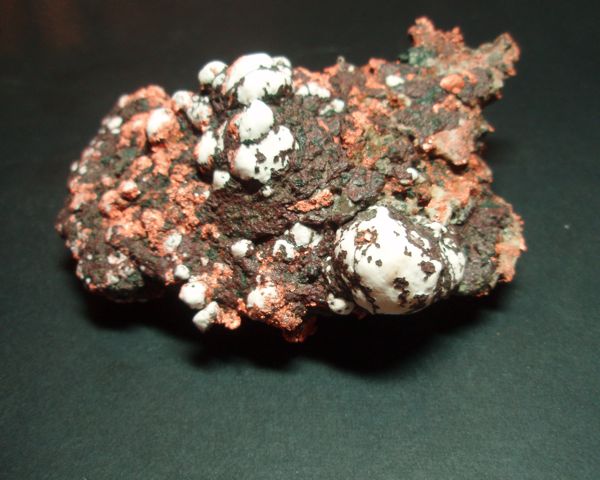
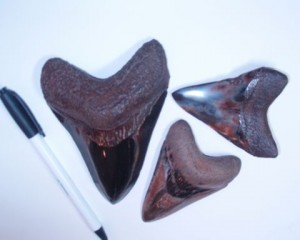 Most sharks have at least six rows of teeth, so a Megalodon had about 276 teeth at any given time.
Most sharks have at least six rows of teeth, so a Megalodon had about 276 teeth at any given time.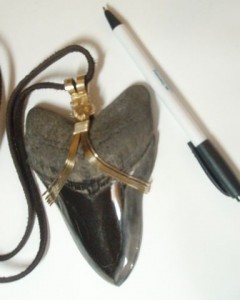 The photo shown is of a bottom front tooth and is a bit over 6 inches.
The photo shown is of a bottom front tooth and is a bit over 6 inches.






